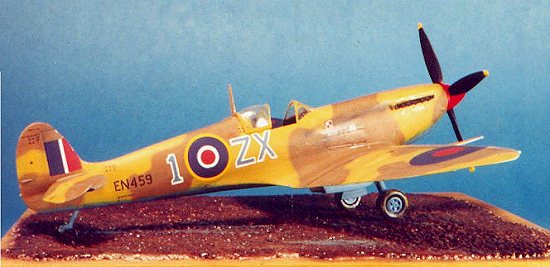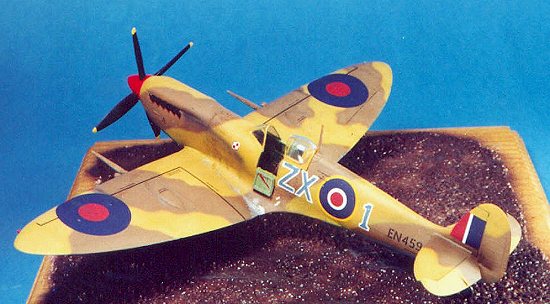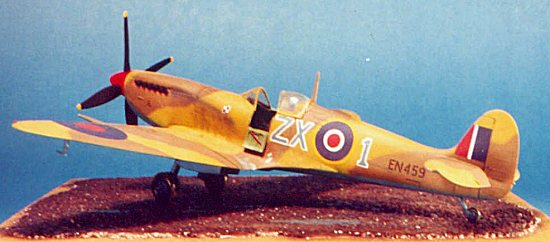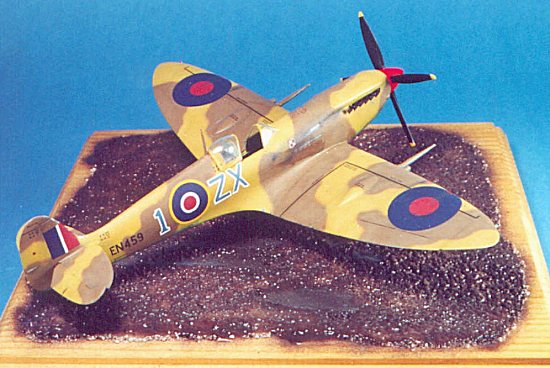
|
KIT: |
ICM 1/48 Spitfire IX |
|
KIT # |
48061 |
|
PRICE: |
$19.98 |
|
DECALS: |
One aircraft |
|
REVIEW & |
|
|
NOTES: |
|

|
HISTORY |
Quite simply, had the Spitfire not been as plastic as it was - able to take increases in power and armament with little modification - the history of the 4th decade of the 20th Century might have been written differently.
Most well-designed airplanes can take increases in power and weight, with some redesign. The same was true of the Spitfire. However, the exigencies of war were such that the airframes that the Supermarine design office took the time to modify appropriately to take full advantage of increases in power through engine changes were not the major airframe modifications of the series to see production. In fact, the three major types that are representative of the increases in power - from low rated early Merlin to single-stage supercharging; the advanced two-stage Merlin; and the higher-powered Griffon - were all "interim" airframes that could take the increased power and, being based on airframes already in production, appear in the squadrons at the required strength as rapidly as possible. These were the Spitfire V, a strengthened Mk.I airframe designed to take the Merlin 45, which provided a 25% increase in power; the Spitfire IX, based on the Spitfire V airframe and able to use the Merlin-60 series engine with two-stage supercharging; and the Spitfire XIV, based on the airframe of the Mk.VIII - which was supposed to be the "definitive" Merlin-60 series airframe - utilizing the Griffon 60 series. Each of these "stopgaps" were produced in far greater numbers than the well-engineered "definitive" airframe for that engine.
 The Spitfire IX is the
direct result of the nasty surprise" the RAF received in the fall of 1941,
when a strange radial engined fighter began to appear in the German units on the
Channel coast. In the summer of 1942, the RAF was given the "gift" of
a brand new Fw-190A-3 when its pilot mistook RAF Pembrey on the southern coast
of the Bristol Channel for a German airfield on the south coast of the English
Channel; extensive tests were undertaken with the captured Focke-Wulf and the
Spitfire V, which revealed that the only area where the Spit V outshone the
Focke-Wulf was in turning radius. As Al Deere said upon discovering this:
"Turning doesn't win battles!"
The Spitfire IX is the
direct result of the nasty surprise" the RAF received in the fall of 1941,
when a strange radial engined fighter began to appear in the German units on the
Channel coast. In the summer of 1942, the RAF was given the "gift" of
a brand new Fw-190A-3 when its pilot mistook RAF Pembrey on the southern coast
of the Bristol Channel for a German airfield on the south coast of the English
Channel; extensive tests were undertaken with the captured Focke-Wulf and the
Spitfire V, which revealed that the only area where the Spit V outshone the
Focke-Wulf was in turning radius. As Al Deere said upon discovering this:
"Turning doesn't win battles!"
Fortunately for the RAF, at about the time that the Fw-190 first began to appear in the Fall of 1941, the first Spitfire with a Merlin-60 series engine took to the air. The Merlin 60 series had a two-stage supercharger, with an intercooler between the two stages, which gave maximum power of the superb Merlin engine well above 20,000 ft., which heretofore had been about the maximum operating altitude of the Spitfire with full power. The plan was to produce the Spitfire VII and VIII, with airframes suitably strengthened to take the excess power, but their appearance in squadron strength was over a year away.
Tests demonstrated that a beefed-up Spitfire V airframe could absorb the extra power successfully, and this modification would put Merlin 60-powered Spitfires into the Squadrons by the summer of 1942. Even at that, it was almost too late. The Spitfire IX first appeared in time to fly top cover over the Dieppe Raid with 64 Squadron in August 1942, but it was not until the fall of 1943 that the front line squadrons of Fighter Command could finally say good-bye to the Spitfire V.
Poles in the RAF:
 It is a little-known
fact that the fourth-largest armed force raised in the Allied cause - after the
Soviet Union, the United States, and the British Commonwealth - was that of
Poland, the first nation conquered by the Nazis in World War II. Polish pilots,
who fled after the fall of their country, provided the decisive edge to the RAF
in the Battle of Britain. Polish soldiers, interned by the Soviets who stabbed
them in the back after the Germans had defeated them in the field, survived
Stalin's gulags to finally make their way to England, where their forces were
decisive in the breakout from Normandy in July 1944. When one considers that
this armed force had no draft, that every man was a volunteer, that they had to
fight a personal war to get to the recruiting office, their accomplishment is
the greater.
It is a little-known
fact that the fourth-largest armed force raised in the Allied cause - after the
Soviet Union, the United States, and the British Commonwealth - was that of
Poland, the first nation conquered by the Nazis in World War II. Polish pilots,
who fled after the fall of their country, provided the decisive edge to the RAF
in the Battle of Britain. Polish soldiers, interned by the Soviets who stabbed
them in the back after the Germans had defeated them in the field, survived
Stalin's gulags to finally make their way to England, where their forces were
decisive in the breakout from Normandy in July 1944. When one considers that
this armed force had no draft, that every man was a volunteer, that they had to
fight a personal war to get to the recruiting office, their accomplishment is
the greater.
The "Polish Fighting Team":
By late 1942, RAF and USAAF units in the Middle East with excellent records might find themselves given a flight of Mk. IXs for "top cover." It was not until the Spring of 1943 that two RAF squadrons - 81 and 72 - were fully equipped with the Spitfire IX, in the face of the introduction of Fw-190s to North Africa by JG2.
The "Polish Fighting Team" was lead by Squadron Leader Stanislaw Skalski, one of the true "greats" of the Polish Air Force, who would end the war as the leading Polish ace. The 15 man unit included aces Eugeniusz Horbaczewski, Karol Pniak, Waclaw Krol, and Kazimierz Sporney, among others. They arrived in the Middle East in February 1943, and were attached to 145 Squadron for administrative purposes. Their job was to provide "top cover" to the RAF fighter bomber units providing support as the noose closed around the Afrika Korps in Tunisia. Between their arrival on the front in early March and the surrender of Axis forces in North Africa on May 13, 1943, the unit made good on their assignment. Skalski added 3 to his eventual score of 24, while Horbaczewski added 5 to his eventual score of 18. The 15 Poles scored over 75 kills in this period.
|
THE KIT |
For an airplane as important as the Merlin-60 series Spitfire, it is incredible that there are no really accurate kits that have ever been made and released, in any scale. I well remember 30 years ago, how it was possible to make an acceptable Mk. IX in 1/72 - if one did a mix-and-match with three different kits! In 1/48, the only thing close is the Otaki Spitfire, which claims to be a Mk. VIII, and is really a late-production Mk.IX with incorrect fabric ailerons (which were not seen on Spitfires from the Mk.V on), and the total absence of the "gulled" lower fuselage-to-wing section. With a bit of mix-and-match using the old Airfix Spitfire V, it is possible to make an acceptable Merlin-60 series Spitfire with this kit as the basis.
 Given this situation,
and based on my previous experience of the company's releases, I was really
looking forward to the release of the Merlin-60 series of Spitfires announced
earlier this year by ICM.
Given this situation,
and based on my previous experience of the company's releases, I was really
looking forward to the release of the Merlin-60 series of Spitfires announced
earlier this year by ICM.
What a disappointment!!!!!!!
The kit is over-engineered, and the "quality control" is not at an acceptable level. I went through three different kits to get one that was barely acceptable, and I stress the word "barely." The kit is a mass of sink-marks that have to be dealt with before you can start assembling the model, assuming they were not short-shot to begin with. I did the Mark IXc, and from the comments I have heard from other modelers whose opinions I respect, I have taken a permanent "pass" on the likelihood of doing any of the others released or to be released.
The one good thing I can say is that this is the first kit of the Merlin-60 series that gets all the bulges and bumps of the cowling area right.
|
CONSTRUCTION |
Once I had spent a few hours puttying and filling the sink holes in all the parts and sanding them out, I was able to begin construction.
If you build this model, do not use any of the interior for the engine compartment if you plan on closing the cowling. These parts are too big to fit within the cowl parts. The firewall, which does need to be used to give solidity to the fuselage and cowling, is oversize and needs to be reduced about 1/32" in width. Test-fit here and do not glue this part in until you have test-fitted the fuselage with the wings to be sure you have narrowed the part enough not to lose the dihedral of the wings.
 When assembling the
cowling, I used 10-mil sheet styrene to make edges that I glued to all the
cowling parts so there would be enough mating surface that the finished
structure would have some stiffness once glued together.
When assembling the
cowling, I used 10-mil sheet styrene to make edges that I glued to all the
cowling parts so there would be enough mating surface that the finished
structure would have some stiffness once glued together.
The seat in the cockpit is completely unacceptable, as are the wheels. Fortunately, I was able to replace both from the spares box.
The clear parts for the canopy are pebbly and about as clear as a coke bottle, even when dipped in Future for several coats. I thought of using a vacuformed canopy, but this wouldn't work due to the too-triangular shape of the upper rear fuselage spine.
I persisted, and was finally rewarded with a fairly accurate looking early-version Mk. IXc, the only one you can make from the kit; the smaller cannon bulges on the gun bay doors for the later versions are completely wrong in shape and size, while the large bulges for the early version are only just barely the correct size and shape.
|
PAINT & DECALS |
Painting:
I had decided to do the Mk.IXc flown by Eugeniusz Horbaczewski in the Polish Fighting Team. These Spitfires undoubtedly came out of the factory in the standard European finish, and were repainted at Aboukir - like most Spitfires used in North Africa - so I freehanded the scheme of dark earth and middle stone, using Gunze-Sanyo's paints for these colors. I later received a color photo of this particular airplane from a friend, and was able to see my surmise about the method of painting was correct.
 Decals:
Decals:
I used the Aeromaster "Spitfire At War Part 6" sheet, and got the correct-color squadron codes from Aeromaster; those are likely now included to begin with if you buy the sheet.
Final Finish:
When I went to put on the landing gear, it turned out the gear legs were too long in the area of the oleo strut, as if they were at maximum extension. Spitfire expert Bob Swaddling has discovered that contemporary Spitfires are operated in this condition; ICM likely picked that up from the 1:1 Spitfire they examined in England. I cut about 1/16" off the strut and got the proper "sit" when finished.
These airplanes had been freshly-delivered at the time the Poles arrived in North Africa, and I opted to do mine as it would have looked at the beginning of their campaign in March 1943, with little chipping and only some exhaust and oil stains.
|
CONCLUSIONS |
I was really looking forward to this kit. Not only was I hoping to finally get an accurate model of the Merlin-60 Spitfires, but it loked like there was a chance that an Eastern European "David" was going to tweak the noses of a pair of Japanese "Goliaths" and in the process turn themselves into a major player in the hobby industry.
Unfortunately, you can't do that with quality control that is the worst I have ever seen of a manufacturer with mainstream intentions. This would be unacceptable with the worst limited-run kit company I ever knew of. I have been told that the Spitfire IXe kit and the Spitfire VIII kits do not contain the right parts, and that in the case of the Spitfire VIII the decal sheet does not have carrier film, making it totally unusable as well as inaccurate.
As you can see from the photos, the completed model certainly looks more like a Spitfire IX than the Occidental or the Otaki competition. However, I would not be able to recommend this kit, even if were it the only one out there of the Spitfire IX.
Fortunately, Hasegawa's Spitfire IX will be out in the stores in mid-April, at a price within US$10 of the price of this ICM offering. If your time is any value to you - say the US$10/hour a journeyman modelmaker gets in Hollywood - when you consider the time you will spend fixing this ICM kit, the Hasegawa Spitfire will be a bargain. We've waited years for an accurate Merlin-60 series Spitfire, and my recommendation is you wait another the additional few months. You won't have to play "modeler's roulette" to get a buildable kit. The Hasegawa kit is advertised as "all new molding," and from what we have seen of the "all new molding" kits of the Shiden-Kai "George" and the F-104 series, all problems should be solved (I hope).
If you would like your product reviewed fairly and quickly by a site that has over 1,700 visits a day, please contact me or see other details in the Note to Contributors.